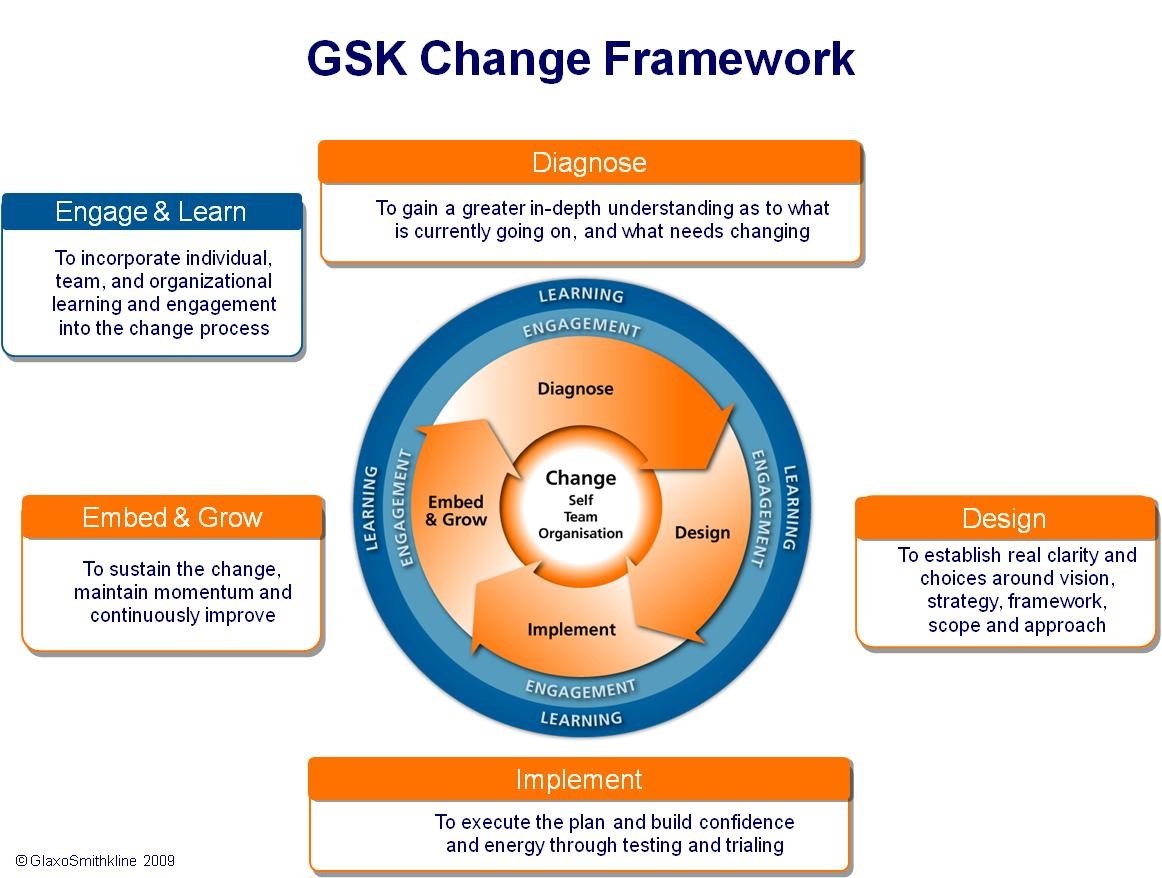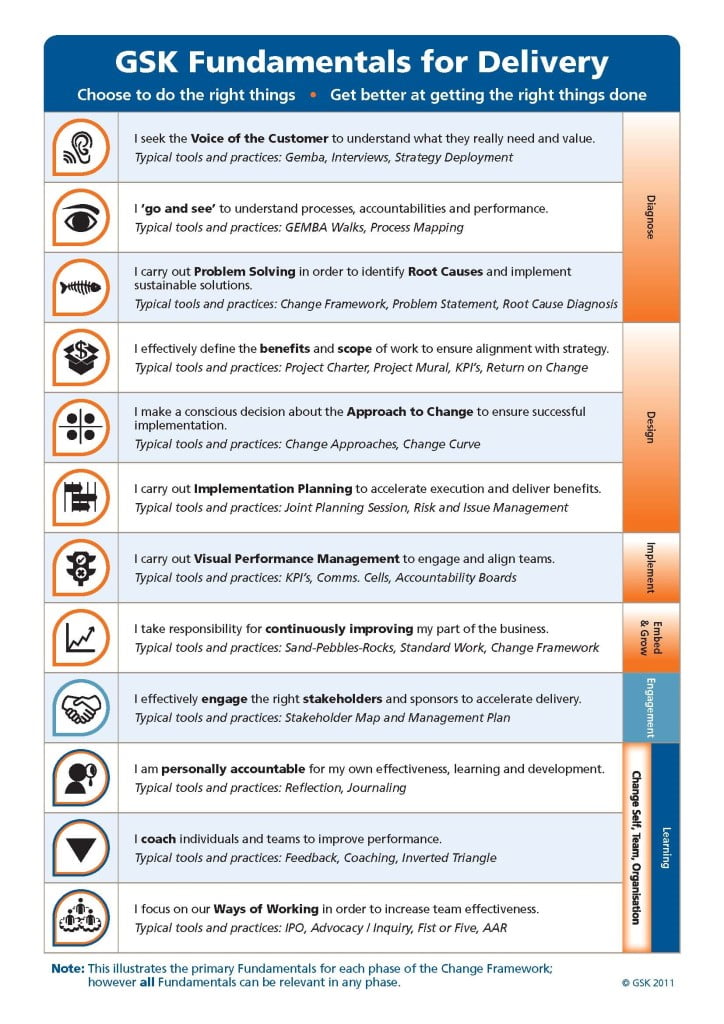CASE STUDY: A new prescription for improving business performance at GlaxoSmithKline
Introduction
GlaxoSmithKline (GSK) is a global healthcare group headquartered in London, UK, engaged in the discovery, development, manufacture and marketing of pharmaceutical products and health-related consumer products. (http:\\www.gsk.com)
Outline
This article will share how we started, scaled up and began to embed the ADP (Accelerating Delivery and Performance) way of working in GSK between 2009 and 2012. We begin with the background and initial objectives followed by a summary of the journey overall. We will then highlight the OD theory that has informed and contributed to this highly practical initiative along with our metrics for success. We continue with our plans for the future and the general lessons we have learned. We conclude with a prologue in which we reflect on our key learnings as OD Practitioners. Significant turning points and the overall impact on the Business are illustrated by comments from line leaders and colleagues in GSK.
Background to ADP
In looking for examples of effective execution across the Company, we noticed that:
- in Global Manufacturing and Supply (GMS) Lean Six Sigma was delivering solid, quantifiable business improvements;
- in the Consumer Healthcare business Project Management was noticeably improving the execution of projects and
- across the company OD teams were driving higher levels of engagement and effective change programmes.
However, none of the 3 disciplines on their own were sufficient to execute GSK’s ambitious strategy. For example, the Lean Six Sigma approach could deliver efficiency and savings, but struggled to affect the predominant mindset through training alone. On the other hand, a purely OD approach ran the risk of ignoring direct, tangible business measures and outcomes in favour of improving capability and behaviours.
Nowhere in GSK were all three disciplines being applied in unison. Our hypothesis was simple – would application of the three disciplines together as ADP, have a greater impact?
Journey of ADP
In mid-2009, with the CEO’s sponsorship, a small team was formed to identify some simple approaches drawn from Organisation Development (OD), Lean Six Sigma (Lean Sigma) and Project Management (PM). The fusion of these approaches became ADP.
Our objectives were as follows:
- Accelerate delivery of the GSK Strategy
- Embed a structured, disciplined way of working
- Use a pragmatic approach to build skills and capabilities in leadership, change and project management and continuous improvement
- Embed GSK values and behaviours to deliver excellence
Table 1 describes the key phases in the ADP journey.
| Phase 1 (2009) | Phase 2 (2010-2011) | Phase 3 (2012 & beyond) | |
| Theme | Early Experiments – start up | Building Momentum & Scale Up | Looking Forward – Embed, Extend & Adapt |
| Goals | Test the ADP hypothesis by applying it to 10 transformation projects | Apply ADP ways of working to more projects and to whole business units as a way of working | Embed a performance-driven culture within GSK through use of the Fundamentals of Delivery |
| Key Activities | · Creation of the GSK Change Framework & identification of OD, Lean Sigma & PM tools · Definition of Core Principles for Accelerating Change · Identification of 10 projects from across GSK business units and countries · Mobilisation of 20 OD, Lean Sigma and PM professionals to form the ADP team · Delivery of Project-based consulting, teaching and coaching · GEMBA visits to see similar ways of working at external companies | · Delivery of ‘Beacon’ projects to further prove the ADP concepts · GEMBA visits to see ways of working in GSK sites · Capability build through Field, Forum, Fieldwork approach · International World Café to apply learning & insight · Cross Skilling of OD, Lean Sigma & PM consultant in ADP team · Leaders modelling ADP ways of working | · Extend ADP work to Emerging Markets, Asia Pacific, South America and Africa (moving staff ‘east’) · Maintain and improve standard approaches · Adapt ADP ways of working for rapid adoption in non-western geographies · Leverage practitioner community to extend capability build |
| Milestones | · Project Learning Review to decide whether to proceed with ADP experiment or not | · Definition of the GSK Fundamentals of Delivery · Investment by early adopter businesses in dedicated ADP resource | · Definition of ADP Consultant Role (single hybrid role) · Investment in dedicated ADP consultants by ‘late’ adopter businesses |
One of the first deliverables of ADP was the GSK Change Framework, which established a common language and a consistent, structured approach to change. By synthesizing the best of the multiple frameworks and models in use in OD, Lean Sigma and Project Management, e.g. Bridges model (Bridges, 1991), PDCA (Deming,1986), DMAIC (Harry, 1998), Project Management models (PMBOK, 2008) we collaborated to create something that was simple and accessible to leaders and their teams as they underwent business transformation. Both the framework itself, and the way it was developed began to embody the values and intent of ADP. The GSK Change Framework is illustrated in Figure 1. The Change Framework has proven to be extremely valuable in GSK and has since been rapidly and extensively adopted. It is an enduring and unchanging element and foundation of the ADP approach. Our lesson – simplicity comes from working through complexity.
At the heart of ADP is a set of six core principles for accelerating change:
- All change starts with self
- Active, committed and visible sponsorship by key stakeholders (at all levels) is imperative
- Ensure that simple, time-bound measures tied to financial/business results are defined
- Include people who are impacted by change to own and design it
- Focus on the few vital things that you can change now
- Design fit for purpose solutions that address customer needs, not wants
Another crucial point in the journey came in February 2010, when the ADP team clarified the targets and key metrics for success. A key strategy for scale-up in Phase 2 was the development of an ambitious number of ‘ADP Practitioners’ – individuals from a wide range of occupations across the business who became skilled in ADP ways of working in order to create capability in others. However, by the summer of 2010, we realised that delivery of this ‘practitioner’ metric was at risk. Modelling our own principles, we ran a 3 day ‘kaizen’ event, soliciting voice of the customer and using focussed problem solving to identify what we needed to do differently. The output of this work was the ‘GSK Fundamentals of Delivery’ – a one page definition of a simple and accessible way of working that teams could learn and apply immediately in their daily work. In plain language the ‘simple sticky stuff’ that could improve everyday work, not just strategic projects.
The Fundamentals focus on “Choosing to do the right things” & “Getting better at getting the right things done”. They are illustrated in Fig 2 and demonstrate the fusion of practices, tools and behaviours from OD, Lean Sigma and Project Management:
OD contributions to ADP
OD thinking was key to the design of ADP and the new ways of working – one that embodied action learning (Lewin, 1947; Weisbord, 1987), use of self as consulting instrument (Cheung-Judge. M. , 2001; Seashore et al, 2004), systems thinking (Macintosh and MacLean, 1999), complexity theory (Stacey, 1996), capability building, engagement and group process (Argyris and Schön, 1974; Schein, 1988), all with a strong focus on improving business performance. We also drew on recent thinking on leadership practices that sustain organisational change (Rowland and Higgs, 2008).
The main contributions of OD were:
- Designing processes to encourage co-construction, for example the GSK Change Framework and the Fundamentals. This collaborative approach involved a broad spectrum of specialists, internal customers and sponsors in an intensive workshop environment.
- Maximising the value and challenge of different mindsets – by forming a team with different skills and practices from PM, Lean Sigma and OD. Lean Sigma and PM thinking arguably come from a logical-rational ‘left brain’ and critical mindset that focuses on problems to be solved. On the other hand, OD comes from an appreciative, socio-emotional ‘right brain’ mindset that focuses on behavioural and human system change as the key to improvement. Fusing the perspectives together gave us the ‘best of both worlds’, but also meant we had to dig deep into our psyche to adjust to thinking both ways.
- Setting a relationship protocol between ADP consultants was significant. The pairs and trios of consultants who were most successful demonstrated a great respect for their peers and a passion for learning one another’s craft. Having an open mind to other expert disciplines was crucial to the success of these partnerships.
- Modelling the change; the ADP team does not introduce or teach anything that we have not applied to ourselves and integrated into our ways of working (Block, 1988). This gives our consultants credibility in the eyes of our customers – we don’t just teach, we apply to ‘self first’ and seek to be a model of the change we wish to see.
- Applying the OD cycle – as the ADP team engaged with the customers, a clear diagnosis of the current state of each project was established as the start of a consulting cycle working around the GSK Change Framework. This defined business problems and opportunities for sustainable improvements – all with a keen eye on value for the external customer and patient.
- Building leadership belief and trust. At the outset GSK leaders were at best, neutral and at worst, deeply cynical. Small Beacon projects helped to establish ‘proof of concept’. Beacon projects were typically found at the ‘front line’ of the organisation, such as the sales force, factory floor or medicine delivery teams. It seemed that by fusing the disciplines of Lean Sigma and PM that produce ‘hard’ benefits with the ‘soft’ benefits of OD in highly visible parts of the business, we were able to get the attention and support of leaders who wanted
- Choosing a consulting style that moved from ‘expert’ to ‘teacher and coach’. This is how ADP creates self-sustaining capability in the business which sometimes required a change in mindset. We needed to do careful contracting with internal customers, who initially expected a ‘quick fix’ and were unwilling to devote time to learning, practicing and being coached.
- Intervening at the unit of the leader with their team at multiple levels of the system. By intervening at the team level, ADP is applied to a specific problem, resulting in a tangible benefit. The team are taught and coached so they not only solve their problem but develop the skills to do the same thing again and again, so embedding a new way of working. We found that even working on the most basic disciplines of effective meeting practices has delivered significant benefits to teams in time savings and increased productivity.
- Choosing a teaching and coaching framework to build independence and sustained capability. Studies show that to increase retention, adults must experience what they have been taught during training. After three months, adults retain 70% of what they have been taught if they apply it during training, but they retain only 10% if they do not apply it (McCauley and Van Velsor, 2004). Based on this, we apply a “Forum, Fieldwork, Feedback” approach. In a series of ‘Forum’ workshops, intact teams are taught the change framework approaches and get to apply them immediately to their real work; in the ‘fieldwork’ between workshops they are coached and observed in applying their new found knowledge, providing them with critical ‘feedback’.
Metrics
From the early experimental days of 10 projects in 2009, ADP ways of working were applied to over 40 projects in 2010, each of which had clearly quantified business benefits.
The shift for 2011 was to move from projects to application at the Business Unit level; this scale-up was dependent upon developing expertise across all GSK businesses. The ‘early adopter’ Businesses represent approximately half of the GSK workforce; what sets them apart is they are willing to invest in their own dedicated expertise to accelerate the embedding of this new way of working. A constant eye is maintained on delivery of tangible and quantifiable business benefit, as this is where our credibility continues to be built.
Whilst the central ADP team has never expanded beyond a constant 20 people, by the end of 2012 the number of Business aligned consultants and practitioners will easily outweigh the central team. To date, we have built capability in over 350 expert practitioners who are now teaching and coaching the new ways of working. As a result, over 3,000 people are actively applying the ADP approach in their daily work.
The Future of ADP
The programme continues with an ambition of bringing the rigour of ADP to the whole of GSK over the next 3-5years. It will continue to adapt and evolve, just as it has done in the past 2 years, building on the strong foundation that has already breached the ‘tipping point’ (Gladwell 2002, Shapiro and Zigarmi 2010).
The challenge moving forward is to embed and sustain the new capabilities and continue to realise tangible benefits. To achieve this, we continue to operate a ‘pull’ based approach, with no top-down mandates. Once a business unit starts believing the new ways of working deliver results (typically as a result of a one or more beacon projects), they are encouraged to invest in their own (small) team of consultants to establish the new ways of working as the new system.
A challenge we continue to face is the fact that our ADP ways of working were largely developed in the Western world, albeit with moderate successes in Japan and China, so how do we navigate and shape the best solution for GSK’s growth areas of Emerging Markets, Latin America and Asia Pacific? Our initial response to this challenge is to bring talent from the East to the UK and to recruit local staff in these regions to help translate the essence of our work. This dual strategy seems to be working well in this regard.
A second challenge is the maintenance of standards to ensure the ADP ways of working are being understood and applied effectively. Already there are examples where the high speed of adoption has diluted the integrity and effectiveness of the models and tools. Our next challenge is to determine what to standardise rigorously, while still being able to adapt to changing environments and complexity in the systems of GSK. We are committed to encourage the continued ‘viral’ adoption of ADP ways of working.
General Lessons Learned
In the course of our journey in introducing ADP we have learned a number of general lessons, some we hope are new and some may sound familiar.
- Be thoughtful in the choice of projects at the ‘experiment’ phase – start with projects that are at the ‘edges’ of your system – where your organization interfaces with its environment and where value is created, for example sales forces, factory floors, product development teams. It is at these edges where the most tangible benefits can be achieved in the shortest timeframe.
- Respond to the opportunities and ‘pull’ presented by your environment – the first 10 projects were the only work that senior executives ‘pushed’ ADP into. From as early as April 2010, the programme worked on a pull basis responding to the energy that the business had.
- Align the programme with GSK’s critical business objectives – from the outset, the intent of ADP was defined by our CEO and Corporate Executive Team. Our purpose was aligned to the transformation strategy for the corporation and all endeavours have been focussed on increasing capability to deliver business critical objectives.
- Define a unifying framework to guide the work of a diverse team – by synthesizing the best approaches from OD, Lean Sigma and Project Management we collaborated early on to create a change framework that was simple and accessible to leaders and teams going through business transformation.
- Recruit the right people onto the team; from all 3 disciplines – those who are willing to experiment, fail, and learn. The ADP team has needed to continually adapt and improve to stay fresh and at the leading edge in an external environment that is constantly changing. In its three years of operating it has evolved every 6–9mths; prompted by our deeper enquiry on what will be needed to take the work to the next level.
- Establish a set of core principles to guide the work of the diverse team – establishing and living the six principles of change helps to align the team on an ongoing basis. Agreement at a philosophical level gives practitioners the freedom to apply their skills effectively.
- Define a standard that is good enough and then improve it over time. Experts from any discipline are naturally inclined to establish high quality approaches – that’s what makes them professional. The paradox faced by ADP was to define a simple (not simplistic) standard and introduce it at speed. The route through this was to choose a fit for purpose approach, put it into action, and then improve it over time, versus investing time in overly sophisticated approaches that become inaccessible. We resisted the pull to ‘get it right first time’ and opted for an approach that modelled learning and improvement through practice and feedback.
- Work in the ‘real work’ and build capability in the process – avoid ‘sheep dip’ training at all costs. ADP develops capability by working in the real work and by teaching and coaching intact teams with their leaders. As ADP is about creating a new habit for work, the team unit provides the best chance of self sustainability and reinforcement. We are repeatedly asked to provide open enrolment training for individuals or groups of specialists; in the small number of instances where we have tried this, the return on investment has been marginal at best.
- Take metrics as seriously as the business does – the ADP team exists to improve the performance of GSK and deliver the capability to sustain ongoing improvement over time. The key to performance management is good metrics and the key to good metrics is to know if you are winning or losing. This philosophy is equally applied within the ADP team where our work is driven by a set of clearly defined lead (activity measures) and lag (outcome measures) indicators.
Prologue: Lessons we have learned as OD Practitioners
Our journey has served to deepen our learning as OD practitioners – these are the key insights that we seek to embed in all future work.
Work in service of clients to enable them to solve their own problems, not to fix problems for them. One of the key differentiators in the work of ADP is to move away from being expert internal consultants called on to fix problems for our business teams and move towards a team who teaches our business teams how they can fix their own problems. In so doing we reduce their reliance on ADP staff for future challenges. However this simple principle is not always easy to implement, especially when teams want a quick fix, don’t have the time to get involved themselves and want consultants to do the heavy lifting.
Practice what you preach – it will give you credibility with your business customers and demonstrates that change starts with self. Throughout its journey, the ADP team has never introduced a practice that it hasn’t tested on itself. This makes the team better and more credible teachers when they take a practice to the wider organisation.
Looking through 3 lenses on change and improvement provides a richer picture and delivers a bigger impact. The fusion of OD with PM and Lean Sigma has been singularly the most critical component in the ADP journey. Each discipline has great depth and wisdom and we have discovered the three are highly complementary – when you fuse and combine them something magical occurs. The multi faceted approach to dealing with the hard edge of business problems, intervening at the level of self, team and organization with the disciplined backbone of Lean sigma philosophy and practice is key.
‘Action-Coaching’ to develop role model leaders has had a major impact. The ADP style of coaching is to observe, provide feedback and suggest improvements as they occur. By being present and intervening ‘in the moment’, leaders and teams receive immediate performance feedback on which they can act and improve. We teach teams to develop this capability to sustain their performance improvement over time.
By Margaret Huggins, MSc and Jacqui Alexander
 Margaret Huggins, MSc, is a Lead Consultant in the Business Improvement team (ADP – Accelerating Delivery and Performance) at GSK plc, based in London, UK. Her early career in Human Resources included the IT and Pharmaceutical industries, working across the UK, the US and diverse international locations. Since 2005 she focussed mainly on the field of Organisation Development and Change Management, providing internal consultancy, coaching and change management to teams in GSK. During this period she also gained a Masters Degree with distinction in Organisation Development at Birkbeck, University of London, and successfully completed the NTL UK OD Certificate Programme. In 2009, she joined the newly founded ADP team and helped to architect the strategy and operating model for this unique approach in GSK. Margaret’s consulting experience extends across business improvement, change management and capability development in a complex, global organisation, and as a leadership team member, she continues to shape the future of ADP.
Margaret Huggins, MSc, is a Lead Consultant in the Business Improvement team (ADP – Accelerating Delivery and Performance) at GSK plc, based in London, UK. Her early career in Human Resources included the IT and Pharmaceutical industries, working across the UK, the US and diverse international locations. Since 2005 she focussed mainly on the field of Organisation Development and Change Management, providing internal consultancy, coaching and change management to teams in GSK. During this period she also gained a Masters Degree with distinction in Organisation Development at Birkbeck, University of London, and successfully completed the NTL UK OD Certificate Programme. In 2009, she joined the newly founded ADP team and helped to architect the strategy and operating model for this unique approach in GSK. Margaret’s consulting experience extends across business improvement, change management and capability development in a complex, global organisation, and as a leadership team member, she continues to shape the future of ADP.
She can be reached at margaret.r.huggins@gsk.com
 Jacqui is Vice President of Accelerating Delivery & Performance (ADP) at GlaxoSmithKline (GSK) in the Talent, Leadership & OD Centre of Excellence. Graduating with an Honours degree in Business, she enjoyed a successful 13yr career in Management Consultancy before joining Glaxo Wellcome in 1999 as leader of the Business Redesign Office. In 2001, she was appointed as leader of post merger integration and redesign for GSK’s Research & Development business. From 2003, her work in GSK became increasingly focussed on change – in coaching individuals, developing high performing teams and leading complex, high magnitude organisational change. In 2009 she joined the Accelerated Delivery Programme team and was promoted as a leader of the programme in the following year. Jacqui has extensive international experience in business transformation, organisation development, consultancy and coaching; she is passionate about organisation and people transformation that delivers outstanding personal and business results.
Jacqui is Vice President of Accelerating Delivery & Performance (ADP) at GlaxoSmithKline (GSK) in the Talent, Leadership & OD Centre of Excellence. Graduating with an Honours degree in Business, she enjoyed a successful 13yr career in Management Consultancy before joining Glaxo Wellcome in 1999 as leader of the Business Redesign Office. In 2001, she was appointed as leader of post merger integration and redesign for GSK’s Research & Development business. From 2003, her work in GSK became increasingly focussed on change – in coaching individuals, developing high performing teams and leading complex, high magnitude organisational change. In 2009 she joined the Accelerated Delivery Programme team and was promoted as a leader of the programme in the following year. Jacqui has extensive international experience in business transformation, organisation development, consultancy and coaching; she is passionate about organisation and people transformation that delivers outstanding personal and business results.
She can be reached at jacqui.k.alexander@gsk.com
References
- Argyris, C. and Schon, D. (1974) Theory in practice: Increasing professional effectiveness. San Francisco: Jossey Bass.
- Block, P. (1988). The Empowered Manager: positive political skills at work. San Francisco: Jossey-Bass
- Bridges, W. (1991). Managing transitions: Making the most of change. New York: Perseus Publishing
- Cheung-Judge. M. (2001) Self as Instrument. OD Practitioner. Vol 33 (3)
- Deming, W. (1986). Out of the Crisis. MIT Centre for Advanced Engineering Study
- Gladwell. M. (2002). The Tipping Point: how little things can make a big difference. Little, Brown & Co.
- Harry, M. (1998) Six Sigma: a breakthrough strategy for profitability. Quality Progress. 31, 5
- Lewin, K. (1947). Frontiers in group dynamics: Human Relations, 1 (2), pp 150-51.
- MacIntosh, R. and MacLean, D. and Stacey, R. and Griffin, D. (Eds.) (2006) Complexity and Organization: Readings and Conversations. Routledge, London, UK
- McCauley.D. and Van Velsor. E. (Eds.) (2004) The Center for Creative Leadership Handbook of Leadership Development. San Francisco: Jossey-Bass
- Project Management Institute (2008) A Guide to the Project Management Body of Knowledge. (PMBOK guide) Project Management Institute.
- Rowland, D. And Higgs, M. (2008) Sustaining Change: Leadership that works. San Francisco: Jossey-Bass
- Schein, E.H. (1988) Process Consultation: It’s role in organization development Vol 1, 2nd edition. Addison-Wesley, Reading, MA
- Seashore, C. and Shawver, M. and Thompson, G. and Mattareet, M. (2004). Doing good by knowing who you are: the instrumental self as an instrument of change. OD Practitioner, Vol 36 (3).
- Shapiro, A. and Zigarmi, P. (2010). Creating Contagious Commitment: applying the Tipping Point to Organisational Change. Strategy Perspective, Hillsborough, NC, USA
- Stacey, R. (1996). Complexity and creativity in organizations. San Francisco: Berrett-Koehler
- Weisbord, M. (1987). Productive workplaces. San Francisco: Jossey-Bass.







